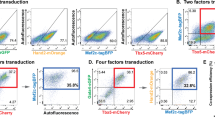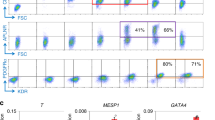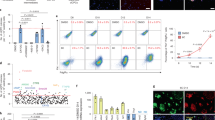Abstract
Here we describe a protocol to generate expandable and multipotent induced cardiac progenitor cells (iCPCs) from mouse adult fibroblasts using forced expression of Mesp1, Tbx5, Gata4, Nkx2.5 and Baf60c (MTGNB) along with activation of Wnt and JAK/STAT signaling. This method does not use iPS cell factors and thus differs from cell activation and signaling-directed (CASD) reprogramming to cardiac progenitors. Our method is specific to direct CPC reprogramming, whereas CASD reprogramming can generate various cell types depending on culture conditions and raises the possibility of transitioning through a pluripotent cell state. The protocol describes how to isolate and infect primary fibroblasts; induce reprogramming and observe iCPC colonies; expand and characterize reprogrammed iCPCs by immunostaining, flow cytometry and gene expression; differentiate iCPCs in vitro into cardiac-lineage cells; and test the embryonic potency of iCPCs via injection into the cardiac crescent of mouse embryos. A scientist experienced in molecular cell biology and embryology can reproduce this protocol in 12–16 weeks. iCPCs can be used for studying cardiac biology, drug discovery and regenerative medicine.
This is a preview of subscription content, access via your institution
Access options
Access Nature and 54 other Nature Portfolio journals
Get Nature+, our best-value online-access subscription
$29.99 / 30 days
cancel any time
Subscribe to this journal
Receive 12 print issues and online access
$259.00 per year
only $21.58 per issue
Buy this article
- Purchase on Springer Link
- Instant access to full article PDF
Prices may be subject to local taxes which are calculated during checkout






Similar content being viewed by others
References
Vierbuchen, T. et al. Direct conversion of fibroblasts to functional neurons by defined factors. Nature 463, 1035–1041 (2010).
Sekiya, S. & Suzuki, A. Direct conversion of mouse fibroblasts to hepatocyte-like cells by defined factors. Nature 475, 390–393 (2011).
Han, D.W. et al. Direct reprogramming of fibroblasts into neural stem cells by defined factors. Cell Stem Cell 10, 465–472 (2012).
Yu, B. et al. Reprogramming fibroblasts into bipotential hepatic stem cells by defined factors. Cell Stem Cell 13, 328–340 (2013).
Yang, N. et al. Generation of oligodendroglial cells by direct lineage conversion. Nat. Biotechnol. 31, 434–439 (2013).
Riddell, J. et al. Reprogramming committed murine blood cells to induced hematopoietic stem cells with defined factors. Cell 157, 549–564 (2014).
Protze, S. et al. A new approach to transcription factor screening for reprogramming of fibroblasts to cardiomyocyte-like cells. J. Mol. Cell. Cardiol. 53, 323–332 (2012).
Ieda, M. et al. Direct reprogramming of fibroblasts into functional cardiomyocytes by defined factors. Cell 142, 375–386 (2010).
Jayawardena, T.M. et al. MicroRNA-mediated in vitro and in vivo direct reprogramming of cardiac fibroblasts to cardiomyocytes. Circ. Res. 110, 1465–1473 (2012).
Nam, Y.J. et al. Reprogramming of human fibroblasts toward a cardiac fate. Proc. Natl. Acad. Sci. USA 110, 5588–5593 (2013).
Fu, J.D. et al. Direct reprogramming of human fibroblasts toward a cardiomyocyte-like state. Stem Cell Reports 1, 235–247 (2013).
Wada, R. et al. Induction of human cardiomyocyte-like cells from fibroblasts by defined factors. Proc. Natl. Acad. Sci. USA 110, 12667–12672 (2013).
Lalit, P.A. et al. Lineage reprogramming of fibroblasts into proliferative induced cardiac progenitor cells by defined factors. Cell Stem Cell 18, 354–367 (2016).
Lalit, P.A., Hei, D.J., Raval, A.N. & Kamp, T.J. Induced pluripotent stem cells for post-myocardial infarction repair: remarkable opportunities and challenges. Circ. Res. 114, 1328–1345 (2014).
Masino, A.M. et al. Transcriptional regulation of cardiac progenitor cell populations. Circ. Res. 95, 389–397 (2004).
Abu-Issa, R. & Kirby, M.L. Heart field: from mesoderm to heart tube. Annu. Rev. Cell Dev. Biol. 23, 45–68 (2007).
Bondue, A. et al. Mesp1 acts as a master regulator of multipotent cardiovascular progenitor specification. Cell Stem Cell 3, 69–84 (2008).
Oh, H. et al. Cardiac progenitor cells from adult myocardium: homing, differentiation, and fusion after infarction. Proc. Natl. Acad. Sci. USA 100, 12313–12318 (2003).
Gardner, R.L. Extrinsic factors in cellular differentiation. Int. J. Dev. Biol. 37, 47–50 (1993).
Qian, L., Berry, E.C., Fu, J.D., Ieda, M. & Srivastava, D. Reprogramming of mouse fibroblasts into cardiomyocyte-like cells in vitro. Nat. Protoc. 8, 1204–1215 (2013).
Cao, N. et al. Conversion of human fibroblasts into functional cardiomyocytes by small molecules. Science 352, 1216–1220 (2016).
Song, K. et al. Heart repair by reprogramming non-myocytes with cardiac transcription factors. Nature 485, 599–604 (2012).
Qian, L. et al. In vivo reprogramming of murine cardiac fibroblasts into induced cardiomyocytes. Nature 485, 593–598 (2012).
Islas, J.F. et al. Transcription factors ETS2 and MESP1 transdifferentiate human dermal fibroblasts into cardiac progenitors. Proc. Natl. Acad. Sci. USA 109, 13016–13021 (2012).
Zhang, Y. et al. Expandable cardiovascular progenitor cells reprogrammed from fibroblasts. Cell Stem Cell 18, 368–381 (2016).
Zhu, S., Wang, H. & Ding, S. Reprogramming fibroblasts toward cardiomyocytes, neural stem cells and hepatocytes by cell activation and signaling-directed lineage conversion. Nat. Protoc. 10, 959–973 (2015).
Maza, I. et al. Transient acquisition of pluripotency during somatic cell transdifferentiation with iPSC reprogramming factors. Nat. Biotechnol. 33, 769–774 (2015).
Bar-Nur, O. et al. Lineage conversion induced by pluripotency factors involves transient passage through an iPSC stage. Nat. Biotechnol. 33, 761–768 (2015).
Nelson, D.O. et al. Irx4 marks a multipotent, ventricular-specific progenitor cell. Stem Cells 34, 2875–2888 (2016).
Downs, K.M. In vitro methods for studying vascularization of the murine allantois and allantoic union with the chorion. Methods Mol. Med. 121, 241–272 (2006).
Champlin, A.K., Dorr, D.L. & Gates, A.H. Determining the stage of the estrous cycle in the mouse by the appearance of the vagina. Biol. Reprod. 8, 491–494 (1973).
Byers, S.L., Wiles, M.V., Dunn, S.L. & Taft, R.A. Mouse estrous cycle identification tool and images. PLoS One 7, 1–5 (2013).
Downs, K.M. Systematic localization of Oct-3/4 to the gastrulating mouse conceptus suggests manifold roles in mammalian development. Dev. Dyn. 237, 464–475 (2008).
Bustin, S.A. et al. The MIQE guidelines: minimum information for publication of quantitative real-time PCR experiments. Clin. Chem. 55, 611–622 (2009).
Downs, K.M. & Davies, T. Staging of gastrulation in mouse embryos by morphological landmarks in the dissection microscope. Development 118, 1255–1266 (1993).
Cockroft, D.L. in Postimplantation Mammalian Embryos: A Practical Approach (eds. A.J. Copp & D.L. Cockroft) 15–40 (IRL Press, 1990).
Nagy, A., Gertsenstein, M., Vintersten, K. & Behringer, R.R. Manipulating the Mouse Embryo: A Laboratory Manual 3rd edn. (Cold Spring Harbor Laboratory Press, 2003).
Downs, K.M. & Gardner, R.L. An investigation into early placental ontogeny: allantoic attachment to the chorion is selective and developmentally regulated. Development 121, 407–416 (1995).
Acknowledgements
This research was supported by the US National Institutes of Health grants U01HL099773, U01HL134764, R01 HL129798 and S10RR025644 (to T.J.K.); R01 HD042706 and R01 HD079481 (to K.M.D.); T32 HD041921 (to A.M.R.); a predoctoral fellowship R25GM083252 (to A.M.R.); and an AHA predoctoral fellowship 12PRE9520035 (to P.A.L.)
Author information
Authors and Affiliations
Contributions
P.A.L. conceived project, designed and performed experiments, analyzed data and wrote the final manuscript. K.M.D. and A.M.R. carried out animal husbandry. K.M.D. made all the embryo reagents/tools, designed the potency experiments, performed all the embryo dissections/manipulations/injections/potency testing, analyzed data and wrote the embryonic potency testing section of the manuscript. A.M.R. recorded and edited the supplemental videos. T.J.K. designed experiments, analyzed data, contributed to writing the manuscript, provided funding and approved the final manuscript.
Corresponding author
Ethics declarations
Competing interests
T.J.K. is a consultant for Cellular Dynamics International, a division of FujiFilm, which is a stem cell biotechnology company.
Supplementary information
41596_2017_BFnprot2017021_MOESM412_ESM.mov
Splitting of decidual swellings to expose conceptuses. The first deciduum splits nicely into halves, whereas the second requires an additional snip with the forceps to split it into halves. (MOV 8407 kb)
41596_2017_BFnprot2017021_MOESM413_ESM.mov
Shelling out of conceptuses from the decidual halves. The first conceptus is removed directly from the decidual half; its Reichert's membrane will be removed in a separate step (Supplementary Video 5). The second conceptus demonstrates the option of reflecting Reichert's membrane in situ before removing it from the decidual half. (MOV 5603 kb)
41596_2017_BFnprot2017021_MOESM417_ESM.mov
Injection of cells into cardiac crescent. Successful injection into the right cardiac crescent is followed by a deep penetration of the injection pipette into the left cardiac crescent, causing cells to enter the amniotic cavity. (MOV 5648 kb)
41596_2017_BFnprot2017021_MOESM418_ESM.mov
After trimming the ectoplacental cone with the hypodermic needles, an untrimmed conceptus is brought in for a side-by-side comparison. (MOV 1491 kb)
Rights and permissions
About this article
Cite this article
Lalit, P., Rodriguez, A., Downs, K. et al. Generation of multipotent induced cardiac progenitor cells from mouse fibroblasts and potency testing in ex vivo mouse embryos. Nat Protoc 12, 1029–1054 (2017). https://doi.org/10.1038/nprot.2017.021
Published:
Issue Date:
DOI: https://doi.org/10.1038/nprot.2017.021
This article is cited by
-
Renal lineage cells as a source for renal regeneration
Pediatric Research (2018)
Comments
By submitting a comment you agree to abide by our Terms and Community Guidelines. If you find something abusive or that does not comply with our terms or guidelines please flag it as inappropriate.



